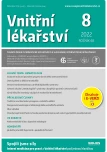Evolution of deep vein thrombosis treatment from leeches to mechanical thrombectomy
Authors:
Jan Raupach 1; Jan Mašek 1; Vendelín Chovanec 1; Radovan Malý 2
Authors‘ workplace:
Radiologická klinika LF UK a FN, Hradec Králové
1; I. interní kardioangiologická klinika LF UK a FN, Hradec Králové
2
Published in:
Vnitř Lék 2022; 68(8): 508-512
Category:
Main Topic
doi:
https://doi.org/10.36290/vnl.2022.108
Overview
Deep vein thrombosis (DVT) is one of the most common diseases in developed countries with significant socioeconomic consequences. The severity of DVT lies in the potential for life-threatening pulmonary embolism and the development of chronic venous insufficiency, referred to as post-thrombotic syndrome. Virchow contributed to the understanding of the pathophysiological events that lead to thrombosis by describing three basic risk mechanisms. The first therapeutic attempts in the 17th century included venepuncture and the application of leeches. The first anticoagulant drug was heparin, which entered clinical practice after 1935. Subsequent commercialization of oral vitamin K antagonists (warfarin) and the advent of low molecular weight heparin along with compression therapy allowed the expansion of outpatient treatment of DVT. Recently, new oral anticoagulants have been introduced, leading to improved safety due to lower risk of bleeding complications and simplification of the treatment process. The next step in the development of therapeutic options are invasive methods of early thrombus removal, which significantly shorten the process and aim to reduce the occurrence of late complications. These methods include local catheter-directed thrombolysis using tissue plasminogen activator, mechanical thrombectomy and their combination called pharmaco-mechanical thrombectomy. The latter is currently used in patients with acute ilio-femoral DVT.
Keywords:
Deep vein thrombosis – thrombolysis – thrombectomy
Sources
1. Krajina A, Peregrin J. Intervenční radiologie‑miniinvazivní terapie. Hradec Králové: Olga Čermáková. 2005:211-23.
2. Tibbutt DA, Chesterman CN. Pulmonary embolism: current therapeutic concepts. Drugs. 1976;11(3):161-92.
3. Galanaud JP, Laroche JP, Righini M. The history and historical treatments of deep vein thrombosis. J Thromb Haemost. 2013;11(3):402-11.
4. Charles AF, Scott DA. Studies on heparin: Observations on the chemistry of heparin. Biochem J. 1936;30(10):1927-33.
5. Mueller RL, Scheidt S. History of drugs for thrombotic disease. Discovery, development, and directions for the future. Circulation. 1994;89(1):432-49.
6. Boccalon H, Elias A, Chale JJ, Cadene A, Gabriel S. Clinical outcome and cost of hospital vs home treatment of proximal deep vein thrombosis with a low‑molecular‑weight heparin: the Vascular Midi‑Pyrenees study. Arch Intern Med. 2000;160(12):1769-73.
7. Hyers TM. Management of venous thromboembolism: past, present, and future. Arch Intern Med. 2003;163(7):759-68.
8. Baglin T. Prevention of post‑thrombotic syndrome: a case for new oral anticoagulant drugs or for heparins? J Thromb Haemost. 2012;10(8):1702-3.
9. Schoepf UJ, Goldhaber SZ, Costello P. Spiral computed tomography for acute pulmonary embolism. Circulation. 2004;109(18):2160-7.
10. Mannucci PM. Venous thrombosis: the history of knowledge. Pathophysiol Haemost Thromb. 2002;32(5-6):209-12.
11. Moretz WH, Rhode CM, Shepherd MH. Prevention of pulmonary emboli by partial occlusion of the inferior vena cava. Am Surg. 1959;25:617-26.
12. Greenfield LJ. Historical reminiscence: origin of the Greenfield filter. Am Surg. 2010;76(12):1319-20.
13. Barral FG. Vena cava filters: why, when, what and how? J Cardiovasc Surg (Torino). 2008;49(1):35-49.
14. Decousus H, Leizorovicz A, Parent F, Page Y, Tardy B, Girard P, et al. A clinical trial of vena caval filters in the prevention of pulmonary embolism in patients with proximal deep‑vein thrombosis. Prevention du Risque d‘Embolie Pulmonaire par Interruption Cave Study Group. N Engl J Med. 1998;338(7):409-15.
15. Greenfield LJ. The PREPIC Study Group. Eight‑year follow‑up of patients with permanent vena cava filters in the prevention of pulmonary embolism: the PREPIC (Prevention du Risque d‘Embolie Pulmonaire par Interruption Cave) Randomized Study. Perspect Vasc Surg Endovasc Ther. 2006;18(2):187-8.
16. Kaufman JA, Barnes GD, Chaer RA, Cuschieri J, Eberhardt RT, Johnson MS, et al. Society of Interventional Radiology Clinical Practice Guideline for Inferior Vena Cava Filters in the Treatment of Patients with Venous Thromboembolic Disease: Developed in collaboration with the American College of Cardiology, American College of Chest Physicians, American College of Surgeons Committee on Trauma, American Heart Association, Society for Vascular Surgery, and Society for Vascular Medicine. J Vasc Interv Radiol. 2020;31(10):1529-44.
17. Hoyt HS, Smith C. The use of the cystoscopic clot aspirator in thrombectomy and embolectomy. Am J Surg. 1953;86(2):206-7.
18. Fogarty TJ, Krippaehne WW. Catheter Technique for Venous Thrombectomy. Surg Gynecol Obstet. 1965;121:362-4.
19. Christensen LR. PROTAMINE PURIFICATION OF STREPTOKINASE AND EFFECT OF pH AND TEMPERATURE ON REVERSIBLE INACTIVATION. J Gen Physiol. 1947;30(6):465-73.
20. Sherry S. The origin of thrombolytic therapy. J Am Coll Cardiol. 1989;14(4):1085-92.
21. Enden T, Haig Y, Klow NE, Slagsvold CE, Sandvik L, Ghanima W, et al. Long‑term outcome after additional catheter‑directed thrombolysis versus standard treatment for acute iliofemoral deep vein thrombosis (the CaVenT study): a randomised controlled trial. Lancet. 2012;379(9810):31-8.
22. Semba CP, Dake MD. Iliofemoral deep venous thrombosis: aggressive therapy with catheter‑directed thrombolysis. Radiology. 1994;191(2):487-94.
23. Mewissen MW, Seabrook GR, Meissner MH, Cynamon J, Labropoulos N, Haughton SH. Catheter‑directed thrombolysis for lower extremity deep venous thrombosis: report of a national multicenter registry. Radiology. 1999;211(1):39-49.
24. Haig Y, Enden T, Grotta O, Klow NE, Slagsvold CE, Ghanima W, et al. Post‑thrombotic syndrome after catheter‑directed thrombolysis for deep vein thrombosis (CaVenT): 5-year follow‑up results of an open‑ label, randomised controlled trial. Lancet Haematol. 2016;3(2):e64-71.
25. Bucker A, Schmitz‑Rode T, Vorwerk D, Gunther RW. Comparative in vitro study of two percutaneous hydrodynamic thrombectomy systems. J Vasc Interv Radiol. 1996;7(3):445-9.
26. Li GQ, Wang L, Zhang XC. AngioJet Thrombectomy Versus Catheter‑Directed Thrombolysis for Lower Extremity Deep Vein Thrombosis: A Meta‑Analysis of Clinical Trials. Clin Appl Thromb Hemost. 2021;27:10760296211005548.
27. Lichtenberg MKW, Stahlhoff S, Mlynczak K, Golicki D, Gagne P, Razavi MK, et al. Endovascular mechanical thrombectomy versus thrombolysis in patients with iliofemoral deep vein thrombosis – a systematic review and meta‑analysis. Vasa. 2021;50(1):59-67.
Labels
Diabetology Endocrinology Internal medicineArticle was published in
Internal Medicine

2022 Issue 8
Most read in this issue
- Selected severe „haematological“ syndromes in adult intensive care patients
- Today's view of hereditary thrombophilia
- Allergen immunotherapy in treating allergic eosinophilic asthma
- Antithrombotic therapy and digestive endoscopy
